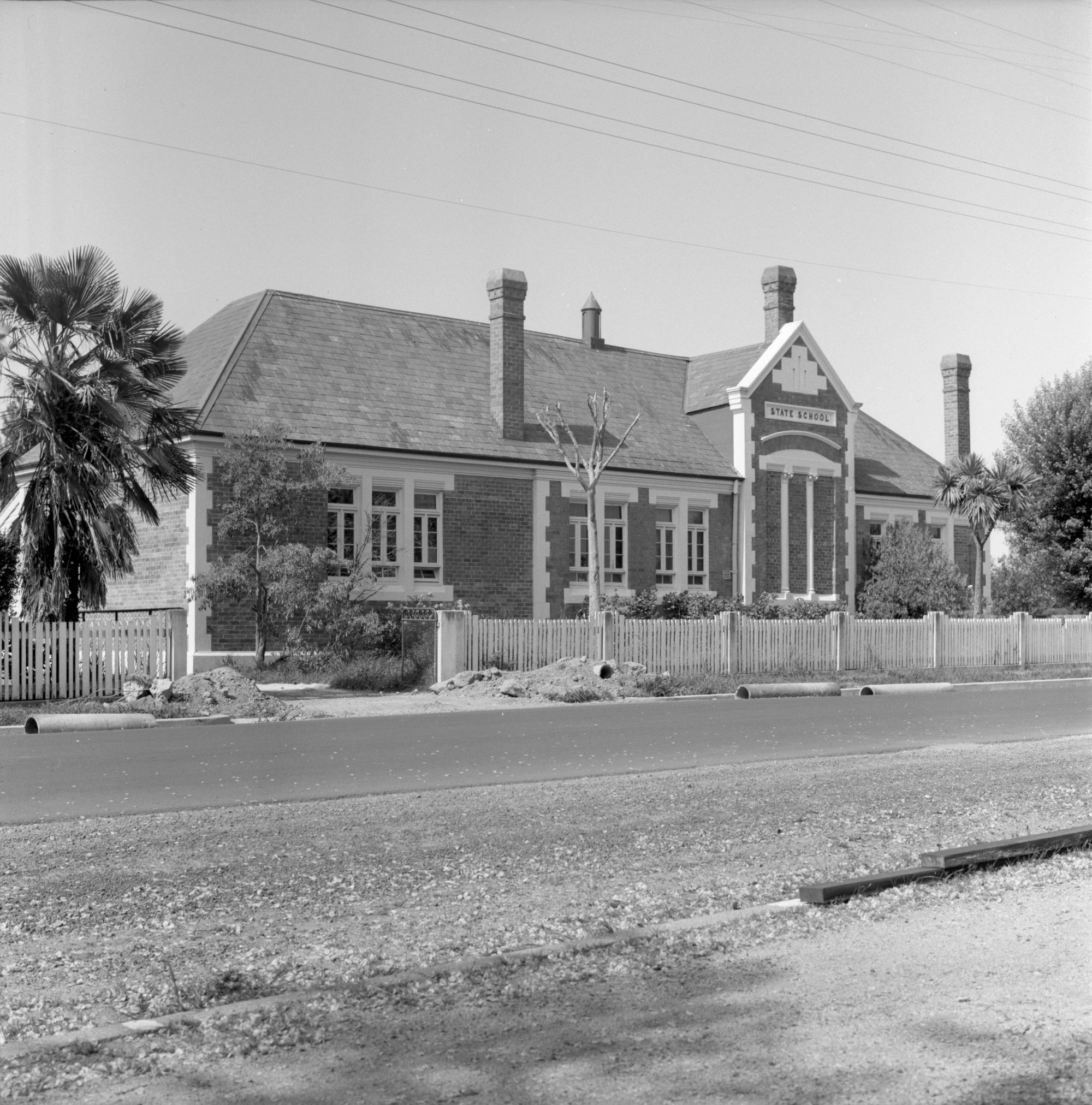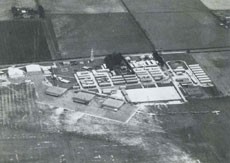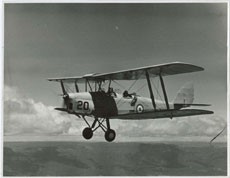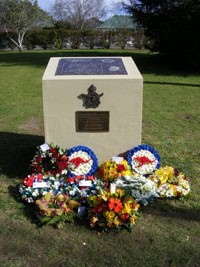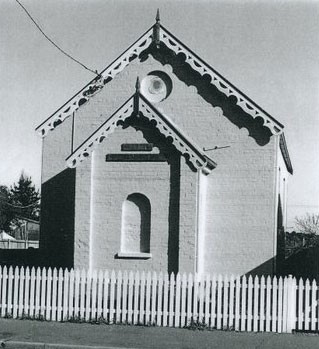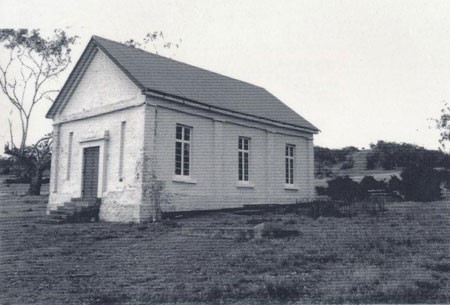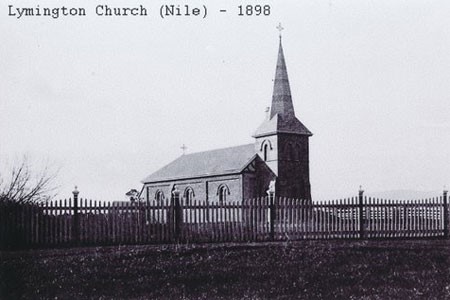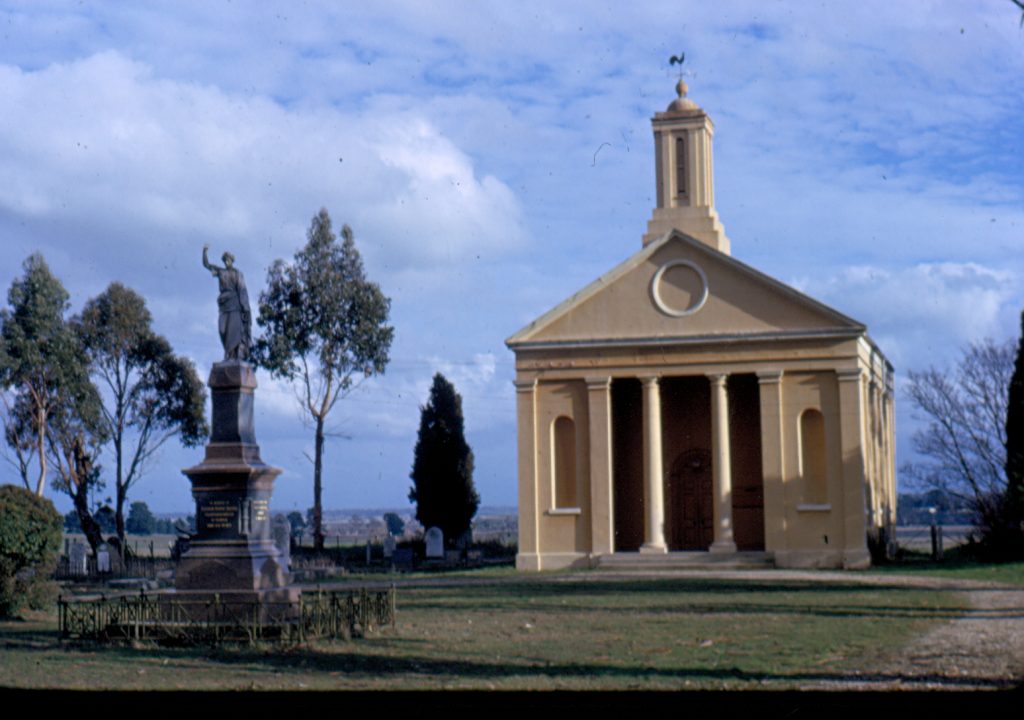Evandale is a heritage treasure in Tasmania. It has many Georgian, and Victorian buildings that remain intact and consequently draws lots of tourists. But when did Evandale become a village?
This was an issue presented to the Evandale History when a new “entrance statement” sign was proposed for Evandale. The previous signage at the entrances to the town said Evandale was established circa 1866, but many people thought how could this be when so many houses, shops, churches and pubs predate this by some time. It is obvious the town was established well before this date. This anomaly led to research being conducted, mainly using the contemporary accounts provided in Trove Digitised Newspapers, with a view to establishing a more accurate date for establishment of the village. The new entrance sign (October 2019) now states: ”Evandale c1830”.
Rationale for the date of circa 1866
In February 1865, a petition was forwarded to the Governor to have Evandale declared a municipality with subsequent alterations to the boundaries of the Launceston and Campbell Town police districts. That is, at least 50 people of the local population wanted the town/district to get its own council. On 20 February 1865, the Colonial Secretary published (1) the proposed boundary of the municipality as:
“Commencing at the source of the North Esk River and bounded by that river to the north-western angle of a grant of 1915 acres to Alexander Rose to Rose’s Rivulet, thence by the north western boundary of that grant, the north-western boundary of a location to James Gildas the north-eastern and part of the north-western boundaries of a location to John Smith to the Main Road from Hobart Town to Launceston, thence by that road to the Longford Municipality, thence by that Municipality to the north-west angle of a location to D. W. Stalker, thence by the main road from Hobart to Launceston to a line in continuation of the north-west boundary of a location of 1500 acres to Edward Wedge, thence to that boundary and by it to the South Esk River, by that river to the Municipality of Fingal, and by that Municipality to the point of commencement.”
Obviously this was a large area that far exceeded to confines of the village of Evandale.
Following consultation including representations by way of petition from owners and occupiers of the police district of Launceston, the Rural Municipality of Evandale was announced, with a few modifications, in October 1865 (2). The first election of Councillors was conducted on Friday 29 December 1865 (3)
So, based on the above information, it can be concluded that while the municipality of Evandale was proclaimed in December 1865 (which is circa 1866), it was for an area far greater than the village itself, and as such has no bearing on the actual date the village was established.
Village location was shifted
Von Stieglitz (4) states that the township site for Morven district was a “reserve” on the edge of the Black Forest about two miles from Evandale. It was to be called Morven. However, because there was no permanent water supply and the locality was otherwise unsuitable, no building was ever erected there for a township. In the same document, Von Stieglitz states that the irregularity was brought to the attention of the Government in 1848 by Assistant Police Magistrate Robert Wales. Subsequently, Governor Denison proclaimed Evandale as the name of the existing village on March 17, 1848. Von Stieglitz states that at that date there were 96 houses and 600 inhabitants.
Obviously, with this population, the town was already in existence at its current location at this time. The name Evandale must have also been in use at this time or the village would have been called Morven.
Village had Different Names
Those with an interest in local history will probably be aware that Evandale is said to have had a variety of names during its existence. These include Honeysuckle Banks, Collins Hill, New River, South Esk, Morven, Evansdale and of course the current Evandale.
Some of these names may have only been references to a district or an area within a district, some may have been names for the village. The resultant investigation revealed the following.
Honeysuckle Banks seems to be derived from the camp site on the South Esk River named by Governor Macquarie in 1811. As this date is just before or just after initial land grants in the area, it could be assumed to predate any establishment of a town. It should also be added that there were no historical newspaper references to this term for the area.
In the case of Evansdale, it is suspected that this name never existed for the current town. A review of Trove Digitised Newspapers does not seem to suggest that this name was ever correctly used. We know that by 1865, Evandale was the name adopted for the municipality so any reference to Evansdale before this date were examined.
The earliest use of Evansdale was 1834 (5) in relation to claims for grants. However the very same article also uses Evandale which suggests a printing error. In this case, it was the Parish of Evandale being referred to, not the town, as shown below.
“Alexander Rose, area 880 acres, Evandale Parish; Alexander Rose, area 850 acres, Breadalbane and Evansdale Parish; Alexander Rose, area 37 acres, Patterson’s Island; Alexander Rose, area 207 acres, Breadalbane and Evandale Parishes; Alexander Rose, area 93 acres, Evandale Parish;”
A similar printing error with the correct use of the town name in the same article also occurred in 1865 (6). No other pre-municipality declaration use of the name Evansdale was discovered in Tasmanian newspapers.
The earliest newspaper use of “Collins Hill” is in 1832 (7) where it is mentioned by a committee, first formed in 1831, in determining the location of the road from Nile to Launceston. It is suggested that Collins Hill was an informal name given to the area first settled by Collins in the early 1820’s on the approach to Evandale from the Nile. Today, this site is occupied by Briar Lane Cottage (formerly Greg and Gill’s Place) which was built in 1826 (8).
At the time of this meeting there were already other adjacent houses. For example, it is also known that Kennedy Murray was already operating a Pound from his home at Prosperous in 1831 (9) and that Prosperous (now Fallgrove) was built circa 1826. Also built in 1826 was Cambock Homestead which was built by Capt. Andrew Barclay (10).
Newspaper references to these other home owners do not use the name “Collins Hill”. Therefore it is suggested that this name was not used for the village but rather as an informal zone within the general area.
“New River” is a term that appears to have been applied to the South Esk River, the district and the settlement. For example, as a river, there is the story (11) of an inquest held at Launceston in January 1823 on the body of a man named Edward Cox, who was “found drowned in the New River, contiguous to his own house. It appeared that the unfortunate man had been stealing some sheep from a Gentleman a short time previously, and to escape the hands of justice, he put an end to his existence by drowning himself; to which effect a verdict was returned accordingly.”
There is an 1828 advert (12) from Joseph Watts and James Carter seeking to inform the public, of their horse breaking skills. They advised clients of their prices and said that horses could be left “at Mr. George Collins’, New River near Gibson’s Ford”. This could be a reference to New River being either a settlement or a District. It should also be noted that it did not refer to Mr Collins living at Collin’s Hill.
New River, was definitely used as a settlement name in and advert placed by Kennedy Murray in May 1831 (13) which read, – “IMPOUNDED = At the Public Pound, Prosperous, New River, Launceston District, on the 9th instant by Mr George Powell..”
“New River” was clearly used as a district name in an advert by Joseph Solomon in 1836 (14) that carried the headline “New Store – Evandale New River – near Captain Barclay’s” respectfully informing “his friends and the inhabitants of Evandale and the District around, that he intends opening a Branch Store.” This advert also suggests that the village was called Evandale and in existence in 1836.
“South Esk” was first used in the newspapers as a river name as early as 1818 (15) with the publication of a Government Public Notice that “Carts going from the Settlements on the Derwent to Port Dalrymple, or to any Part or Place in the Interiorm, do keep the High Road the Whole way; and that they do enter the Settlement of Port Dalrymple by crossing the South Esk, at the Ford between Gibson’s and Massey’s Farms, and at no other Place.” Gibson’s Farm is a reference to Pleasant Banks (off Leighlands Road) and Massey’s Farm was located between Pleasant Banks and current day Evandale.
South Esk was also used as a river name in a government notice published in 1828 (16) which read, “GOVERNMENT NOTICE, No. 147. —- Colonial Secretary’s Office, July 16, 1828 – THE Lieutenant Governor, has been pleased to appoint Mr. William Graves to be Keeper of the Pound near Gibson’s Ford, on the right bank of the South Esk.” This location is very close to the current town and it is interesting to note that just the next month, Mr Graves uses the term South Esk Pound located at Morven, South Esk. Obviously Morven being the settlement and South Esk being the district (17).
Morven has obviously been extensively used as a district name. It was first proclaimed a district and its boundaries were defined in 1823 by a Government Notice (18). Breadalbane District to the north was also proclaimed at the same time. Of note here is the fact that the current location of the town is very close to the boundary of Morven and Breadalbane districts i.e. the South Esk River at Gibson’s Ford. Had a township existed at that time, it is thought that the boundaries would have been located to clearly enclose the township of that time. Other proclamations make mention of the townships that they include.
While there are many references to Morven in the press, there are only a few uses of the phrase “town of Morven” being used. Two of these are in the one newspaper on the same day. There are no uses for the phrase “village of Morven”.
It is of interest to note that the use of “Morven” overlaps with the use of “Evandale”, so there is some confusion. Based on number of occurrences in the newspapers of the day, Evandale was the predominant name for the village and Morven was the district name.
It is interesting to note that in 1825 (19), the district of Morven was identified as now being called South Esk as seen in the following quote. “His Excellency, the Governor having instituted a Court of Requests in and for the Island of Van Diemen’s Land, for the Recovery of Debts not exceeding Ten Pounds Sterling, Notice is hereby given, that the said Court will be opened and held at the Place and Times following- (that is to say) ;….At Campbell ‘Town, on Friday the 27th Day of May next, at Ten o’Clock in the Forenoon precisely, for the Trial of Causes in which Persons residing within the following Districts or Places may be the Defendants; namely-Lennox, Richmond, Morven, (now called South Esk) …..”
Perhaps the earliest use of Morven(as the name of a village) was in 1828 when William Graves advertised stock impounded at the Pound located at Morven, South Esk, 18th August 1828 (20).
It is also worth noting that the blacksmith Mr George Powell, “near the farm of Andrew Barclay Esq” advertised in May 1830 for “two journeymen wheelwrights, who will be supplied with tools and every requisite; or a master tradesman will meet with every encouragement by commencing his business at or near Mr. Powell’s, Morven” (21). This suggests that there was significant work in the area to warrant an expansion of his business or even seek a competitor to meet the demand.
Every Village Needs a Pub and a Church!
Many people would suggest that a place cannot be called a village until it has its own Pub. Well, the first public house in the town area was the Jolly Farmer run by George Collins in 1829 and 1830 (22,23). The second licensed public house was the Patriot King William IV now known as Blenheim, the imposing building at 16 High Street. By one account (24), building of this hotel commenced in 1826 but we do know that it was first licensed on 29 September 1832 (25). The hotel was a rather grand establishment which included an assembly room upstairs that was used for concerts, dancing and a meeting room for the Masonic Lodge and other groups. It was said to also have a skittles alley. All of this points to a significant clientele, either local or passing, however much of this probably came later.
In 1829, there was no church in the settlement despite there being quite a few people living locally. We know this from a letter to the editor of the Cornwall Press and Commercial Advertiser (26) which stated “SIR—Of course you are aware that we have no church or place of worship out here. But I do not suppose you are aware of the manner in which the Sabbath is kept in this neighbourhood. 1 understand a most disgraceful transaction took place last Sunday, in the vicinity of Gibson’s Ford on the South Esk. Several pitched battles were appointed for that day’s amusement, and no fewer than six or seven fights took place, which, of course, had a great many spectators. And as such was the case—the rabble from within 5 or 6 miles round being collected on the spot—I would ask, through your medium, what were the constables doing ? As they could not help but know of it, why were they not there to prevent it ? The worthy Police Magistrate cannot be aware of the queer jobs that are sometimes hushed up within a few miles of town, but which ought to be brought to light and the parties punished. We understand the preliminaries are settled for a fight to take place today, within a few miles of town, for £50;”
Fighting events in the region were very popular because we know from a January 1830 (27) report that stated “A regular pitched battle was fought here on Wednesday last, near the public house kept by Mr. Collins. This battle had been long talked of in Launceston and its neighbourhood, the combatants, James Glew, a man well known by the lovers of pugilism in New South Wales and John Williams, the champion of this place, met upon the ground about one o’clock, with upwards of 700 persons, a greater concourse of people perhaps than was ever assembled before on such an occasion in this island.”
Summarising the Information
Based on the information available, it is possible to conclude that Evandale:
- by 1826, at least a few houses were in close proximity
- by 1828, there is an operating Pound at least adjacent to the settlement area on the South Esk River
- by 1829, there is a licensed public house
- by 1829, there are sufficient people in the settlement and surrounding farms to stage a “sporting” events and that by 1830, one such event attracted upwards of 700 people
- by 1831, we have an operating Pound within the settlement area
- by 1832, we have a grand licensed hotel
- Evandale proclaimed as the name of the existing village on March 17, 1848 but there were already 96 houses and 600 inhabitants
It was also concluded that Evandale, as a settlement, if not a village, has been called New River, South Esk and Morven. Credence is not given to the village having been called Honeysuckle Banks, Evansdale or Collins Hill.
Conclusion
Based on the information collected for this study, it can be assumed that Evandale, as it is now called, was in its infancy in 1826 when it was a small collection of dwellings and out buildings and was definitely an established village by 1832 when there are at least a few non-farming businesses in operation.
Given this spread of dates, The Evandale History Society recommended to Council that circa 1830 be adopted as the establishment date for Evandale. This will be the date that will appear on the new entrance statement and other signs in the near future.
References
- The Cornwall Chronicle (Launceston, Tas. : 1835 – 1880) Sat 25 Feb 1865 Page 5
- Launceston Examiner (Tas. : 1842 – 1899) Thu 12 Oct 1865 Page 5
- The Cornwall Chronicle (Launceston, Tas. : 1835 – 1880) Sat 30 Dec 1865 Page 4
- von Stieglitz, Karl (1946) Days and Ways in Old Evandale
- Launceston Advertiser (Tas. : 1829 – 1846) Thu 5 Jun 1834 Page 2
- The Mercury (Hobart, Tas. : 1860 – 1954) Sat 23 Dec 1865 Page 3
- The Independent (Launceston, Tas. : 1831 – 1835) Sat 27 Oct 1832
- Evandale Heritage Walk, Evandale History Society
- The Tasmanian (Hobart Town, Tas. : 1827 – 1839) Fri 28 Jan 1831 Page 2
- McCormack T (2015) Reaching Out From Trafalar, Bokprint Launceston
- Hobart Town Gazette and Van Diemen’s Land Advertiser (Tas. : 1821 – 1825) Sat 25 Jan 1823 Page 2
- The Tasmanian (Hobart Town, Tas. : 1827 – 1839) Fri 31 Oct 1828 Page 4
- Launceston Advertiser (Tas. : 1829 – 1846) Mon 16 May 1831 Page 157
- Colonial Times (Hobart, Tas. : 1828 – 1857) Tue 22 Nov 1836 Page 3
- The Hobart Town Gazette and Southern Reporter (Tas. : 1816 – 1821) Sat 24 Oct 1818 Page 1
- The Hobart Town Courier (Tas. : 1827 – 1839) Sat 19 Jul 1828 Page 1
- The Hobart Town Courier (Tas. : 1827 – 1839) Sat 23 Aug 1828 Page 1
- Hobart Town Gazette and Van Diemen’s Land Advertiser (Tas.: 1821 – 1825) Sat 20 Dec 1823 Page 1
- Hobart Town Gazette and Van Diemen’s Land Advertiser (Tas. : 1821 – 1825) Fri 25 Mar 1825 Page 1
- The Hobart Town Courier (Tas. : 1827 – 1839) Sat 23 Aug 1828 Page 1
- The Hobart Town Courier (Tas. : 1827 – 1839) Sat 29 May 1830 Page 3
- Colonial Times (Hobart, Tas. : 1828 – 1857) Fri 20 Nov 1829 Page 4
- Launceston Advertiser (Tas. : 1829 – 1846) Mon 20 Sep 1830 Page 3
- The Convict Trail, http://ontheconvicttrail.blogspot.com.au
- The Independent (Launceston, Tas. : 1831 – 1835) Sat 22 Sep 1832 Page 2
- The Cornwall Press and Commercial Advertiser (Launceston, Tas. : 1829) Tue 5 May 1829 Page 4
- The Hobart Town Courier (Tas. : 1827 – 1839) Sat 9 Jan 1830 Page 2
